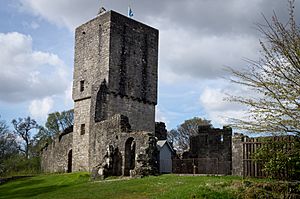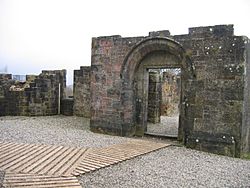Mugdock Castle facts for kids
Quick facts for kids Mugdock Castle |
|
|---|---|
| Strathblane, Scotland |
|

The south facade of Mugdock Castle, with the single remaining tower
|
|
| Coordinates | 55°57′56″N 4°19′28″W / 55.965556°N 4.324444°W |
| Type | Courtyard castle |
| Site information | |
| Owner | Stirling Council |
| Open to the public |
Yes |
| Condition | Ruined |
| Site history | |
| Built | 14th century |
| Built by | David de Graham? |
| In use | Until mid-17th century |
| Materials | Stone |
| Demolished | Slighted 1641 |
Mugdock Castle is an old castle ruin that was once the main home of the Clan Graham family. They lived there from the mid-1200s. You can find the castle today in Mugdock Country Park, which is west of the village of Mugdock in Strathblane, Scotland. It's about 2 kilometers north of Milngavie, near Greater Glasgow.
Contents
A Look Back: Mugdock Castle's History
Who Built Mugdock Castle?
The land where Mugdock Castle stands belonged to the Graham family starting in the mid-1200s. A man named David de Graham of Dundaff got the land from the Earl of Lennox. It's thought that the castle itself was built by one of his family members, Sir David de Graham, or his son, around 1372.
In 1458, the area around Mugdock became known as the Barony of Mugdock. This meant the Grahams had special rights and power over the land. Later, in 1505, the Grahams became even more important when they were given the title of Earls of Montrose.
Battles and Changes at the Castle
One of the most famous Grahams, James Graham, 1st Marquess of Montrose, might have been born at Mugdock Castle in 1612. He was a very important military leader during a time of big changes in Scotland.
During the Bishops' Wars (which led up to the Wars of the Three Kingdoms), Montrose first supported a group called the Covenanters. However, he was later put in prison in Edinburgh in 1641. While he was in prison, a leader named Lord Sinclair attacked and damaged Mugdock Castle.
Montrose returned to the castle after his release. But in 1644, he started fighting for King Charles I in Scotland. Mugdock Castle was attacked and damaged again that same year. After King Charles I was defeated, Montrose was executed in 1650. The castle and land were then taken by his enemy, the Marquess of Argyll.
But the story didn't end there! In 1661, Argyll was also executed. Mugdock Castle was given back to the Graham family. They spent two years fixing it up, even building a new house inside the old castle walls. In 1682, the Grahams bought a grander home called Buchanan Auld House. Even so, Mugdock Castle remained their official family seat for a while.
Mugdock Castle in Later Years
In the 1820s, a beautiful terraced garden with a summer house was built east of the castle. Later, in 1874, a local historian named John Guthrie Smith rented the house. He decided to tear down the 17th-century mansion and build a new house in the Scottish baronial style within the old castle ruins. This new house was designed by famous architects.
During World War II, the government used the house. In 1945, Hugh Fraser, who owned the big department store chain House of Fraser, bought Mugdock Castle from the Duke of Montrose. Sadly, the 19th-century Mugdock House burned down in 1966.
In 1981, Hugh Fraser's son, Sir Hugh Fraser, 2nd Baronet, gave the castle and the land around it to the local council. He wanted it to become a country park for everyone to enjoy. Today, it's still Mugdock Country Park, and you can visit the castle ruins. The main tower of the 14th-century castle has been fixed up and now has a museum inside. Mugdock Castle is a protected historical site.
What Does Mugdock Castle Look Like?
The First Castle
The first Mugdock Castle was built in the mid-1300s. It might have been shaped like a shield, with towers and walls surrounding a central courtyard. The main entrance was in the middle of the south wall. The castle was built on a natural, rocky hill next to Mugdock Loch, which used to be much bigger.
Today, only the south-west tower of the original castle is still standing. This tower is four stories tall. You can enter it on the second floor by using outside steps. Inside, each floor has one room. On the outside, the top two floors stick out a bit, making the tower look "top-heavy." Other parts that remain are the bottom of the north-west tower, part of the gatehouse, and some connecting wall sections.
How the Castle Grew
Mugdock Castle was made bigger in the mid-1400s, probably when the area became a barony. An outer wall was built to create a larger outer courtyard. This courtyard's main entrance was to the south, next to the south-west tower. Inside this courtyard, you can see the ruins of other stone buildings, mostly from the 1500s. These include a chapel and some living areas. Much of this outer wall has disappeared over time.
The Victorian House Ruins
By the late 1800s, most of the castle was in ruins. When John Guthrie Smith built his new mansion, any remains of the eastern towers were removed. The one surviving tower was connected to the new house by a covered walkway on the second floor. The house itself was L-shaped and three stories high, built in the Scottish baronial style. It faced the south-west tower, creating a small courtyard. Most of this house was torn down in 1967, but some walls still stand up to the second-floor level.



